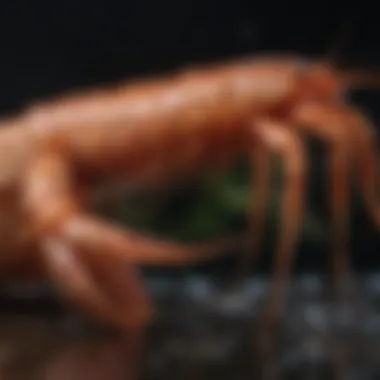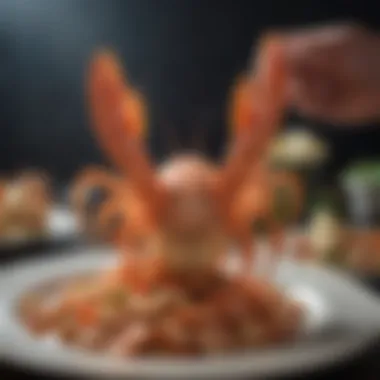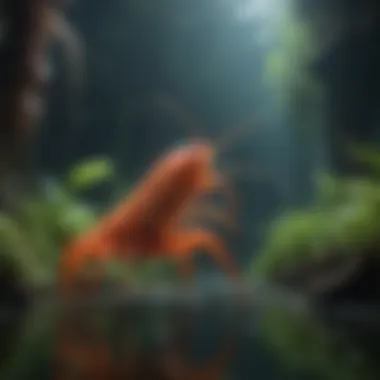Giant Shrimp: Biology, Ecology, and Culinary Impact


Intro
Giant shrimp, often recognized for their notable size and distinct features, represent a thrilling segment of marine biodiversity. Despite their culinary prominence, understanding their biology and ecological roles is crucial for appreciating their significance in various ecosystems. This article aims to provide not just a surface-level examination but a comprehensive exploration of these fascinating creatures. From their taxonomy and habitat preferences to the culinary traditions they influence, we will unfold the multi-faceted world of giant shrimp.
Fascinating Facts About the Animal
Giant shrimp have captured the attention of marine biologists and culinary experts alike. Their unique characteristics contribute to their appeal.
Unique Characteristics
Giant shrimp are known for their impressive size, reaching lengths of up to 12 inches in some species. Their bodies are elongated with an exoskeleton that can be an array of colors. The coloration can vary based on their habitat, providing camouflage from predators.
- Species diversity: There are numerous species of giant shrimp, notably the Penaeus monodon and Litopenaeus vannamei.
- Adaptations: They have developed unique adaptations, allowing them to thrive in various marine environments.
Extraordinary Abilities
Giant shrimp possess remarkable abilities that aid their survival. These include:
- Speed: They can swim quickly to evade threats, utilizing powerful tail flips.
- Regeneration: They can regenerate lost limbs, a useful trait in their predator-filled environments.
Behavior and Habitat
Understanding the behavior and habitat of giant shrimp offers insights into their ecological roles.
Natural Habitats
Giant shrimp inhabit diverse marine environments, from coral reefs to brackish waters. They prefer shallow coastal regions where they find adequate food resources and protection. Their habitats significantly influence their growth and reproduction cycles.
Social Structures
These shrimp often exhibit social behaviors, forming groups that can aid in protection against predators. While they may not have complex social structures, their interactions can highlight aspects of their survival strategies.
Recent Scientific Discoveries
The study of giant shrimp continues to evolve, with researchers uncovering new knowledge.
Latest Research Findings
Recent studies focus on their response to environmental changes. An example is the impact of rising ocean temperatures on their growth rates and reproductive success. These findings reveal the vulnerabilities of giant shrimp in the face of climate change.
Breakthroughs in Animal Biology
Discoveries in microbiome research shed light on how giant shrimp digest food. Understanding their digestive processes opens doors to improved aquaculture practices.
Cultural Significance
Giant shrimp hold a notable cultural significance in many societies.
Animals in Folklore
In various cultures, giant shrimp often appear in local folklore, symbolizing abundance and prosperity. They are linked to myths that emphasize their importance in the ecosystem.
Influence on Art and Literature
Their majestic appearance has inspired artists and writers. From paintings to culinary literature, giant shrimp are celebrated for their role in both nature and human culture.
"Giant shrimp are not merely a delicacy; they represent a rich tapestry of biological, ecological, and cultural threads that connect us to our oceans."
Preface to Giant Shrimp
Giant shrimp are a remarkable and multifaceted subject in marine biology and cuisine. Their notable size and unique biological features set them apart from smaller shrimp species. Understanding these creatures extends beyond simple curiosity; it is crucial for various reasons.


First, giant shrimp play significant roles in their ecosystems. As both predators and prey, they occupy crucial positions in marine food webs. Recognizing their ecological roles helps in understanding the balance of marine environments and the consequences of their decline.
Further, giant shrimp are culturally and economically valuable species. They are a staple in many global cuisines, symbolizing luxury and culinary art. The ways they are prepared and consumed reflect cultural practices and preferences, highlighting their importance in human life.
This section uncovers the need to study giant shrimp thoroughly. Consequently, exploring their biology, ecology, and significance will illuminate their contributions to nature and humans.
Definition and Overview
Giant shrimp, often under the umbrella of the family Penaeidae, are some of the largest crustaceans in the world. They can be found in both tropical and subtropical waters and can grow to significant sizes, with some species reaching lengths of up to a foot. Their robust bodies, elongated forms, and large claws make them distinct among marine fauna.
Biologically, they are classified as decapods, which means they possess ten limbs. These limbs assist not just in locomotion but also in feeding and interaction with their environment. Common species include the Penaeus monodon, known as the black tiger shrimp, and the Penaeus vannamei, or the whiteleg shrimp. Both species are favored in aquaculture.
Their habitats range from estuaries to offshore waters. Giant shrimp are opportunistic feeders, consuming plankton, small fish, and even organic debris. Understanding their characteristics provides insights into their adaptability and resilience in different environments.
Historical Context
The history of giant shrimp is intertwined with human culture. Historical records indicate that giant shrimp have been utilized for food for centuries. In ancient times, coastal communities relied on these creatures for sustenance, leveraging their abundance in surrounding waters.
Trade in shrimp was prevalent across various civilizations. Records suggest that the fishing and consumption of giant shrimp have evolved alongside human development. Techniques for fishing and methods of preparation have transformed dramatically over time. With advances in preservation and culinary techniques, giant shrimp found their way into upscale dining, becoming symbols of gourmet cuisine.
In modern times, giant shrimp fisheries have expanded due to globalization. The rise of aquaculture has also shifted how these shrimp are sourced. The historical narrative of giant shrimp reveals not only the evolution of culinary practices but also the demands placed on marine resources. Understanding this context is vital, especially in light of current sustainability concerns.
Taxonomy of Giant Shrimp
Understanding the taxonomy of giant shrimp is essential for grasping their biology and ecology. Taxonomy, which is the science of classification, allows us to categorize these organisms based on their characteristics, evolutionary history, and relationships with other species. This classification not only aids research but also informs conservation efforts and culinary practices. By examining the taxonomy, we gain insight into the diversity and distribution of giant shrimp across various ecosystems.
Classification
The classification of giant shrimp falls within the domain of crustaceans, specifically the subphylum Malacostraca. They belong to the order Decapoda, which encompasses shrimps, crabs, and lobsters. To further break down their classification:
- Domain: Eukarya
- Kingdom: Animalia
- Phylum: Arthropoda
- Subphylum: Crustacea
- Class: Malacostraca
- Order: Decapoda
- Families: Various families such as Penaeidae and Pandalidae vary in characteristics among species.
This hierarchical structure plays a vital role in scientific communication by providing a standardized framework. Furthermore, it assists researchers in identifying and studying different giant shrimp species more effectively.
Key Species of Giant Shrimp
In the realm of giant shrimp, several notable species warrant attention. These species exemplify the diversity within the taxonomic framework and hold ecological and culinary significance. Some of the key species include:
- Penaeus vannamei: Commonly known as the Pacific white shrimp, it is a major species in aquaculture and is widely consumed globally.
- Penaeus monodon: Also referred to as the black tiger shrimp, this species is recognized for its size and is cultivated extensively in aquafarming.
- Litopenaeus setiferus: Known as the Atlantic white shrimp, this species is prevalent in the Atlantic Ocean and is often part of local fisheries.
These species each have unique traits and habitats, and understanding their taxonomic placements offers valuable insights into their ecological functions and their roles in culinary traditions around the world. They also highlight the importance of sustainability in the fishing and farming practices that involve giant shrimp.
The classification and identification of key giant shrimp species play a critical role in their conservation and management.
Biological Characteristics
Biological characteristics are fundamental in understanding giant shrimp. This section examines their anatomy, physiology, growth, and reproduction. Exploring these aspects provides insights into their adaptations, behavior, and ecological roles. Understanding these biological traits allows researchers and enthusiasts alike to appreciate the complexity of these creatures.
Anatomy and Physiology
Giant shrimp possess unique anatomical features. Their exoskeleton is both lightweight and strong, allowing for mobility and protection. This structure is made primarily of chitin, which contributes to their resilience against environmental threats.
Their bodies are segmented into three main parts: the cephalothorax, abdomen, and tail. The cephalothorax combines the head and thorax, housing vital organs and the mandibles that are crucial for feeding. The abdomen is long and flexible, aiding in locomotion. In terms of physiology, giant shrimp have a specialized respiratory system. They utilize gills to extract oxygen from water, which is essential for their survival.
Furthermore, their compound eyes offer a broad field of vision, enhancing their ability to detect predators and prey. The remarkable sensory capabilities of these eyes underscore their adaptations to marine environments. The importance of understanding these anatomical and physiological aspects cannot be overstated, as they are vital to the shrimp's survival and reproductive success.
Growth and Reproduction
The growth and reproductive strategies of giant shrimp are of great interest. They undergo a process called molting, where they shed their exoskeleton to grow. This process allows for significant size increases but also leaves them vulnerable temporarily. The timing of molting is crucial, often influenced by environmental conditions, such as temperature and salinity levels.
Reproduction typically occurs through a complex mating ritual. Female giant shrimp often exhibit specific behaviors to attract males. Once fertilization occurs, females carry the eggs under their tails. This parental care is beneficial, as it increases the offspring's chances of survival.
Giant shrimp can reproduce multiple times in a year. Their lifespan can vary, but many species can live for several years, allowing for multiple reproductive cycles. Understanding the growth and reproduction of giant shrimp is essential for effective conservation and aquaculture practices. Research in this area can provide insights into maintaining healthy populations and supporting culinary industries.


Understanding the biological characteristics of giant shrimp is crucial for conservation efforts and sustainable fishing practices.
Maintenance of healthy shrimp populations supports biodiversity and ensures the sustainability of fishing industries. As the demand for giant shrimp continues to grow, knowledge in this field becomes increasingly relevant.
Habitat and Distribution
Understanding the habitat and distribution of giant shrimp is crucial for comprehending their ecology and conservation. Their habitats influence their growth, reproductive success, and interactions with other marine organisms. Moreover, knowledge of their distribution helps in making informed decisions regarding management and conservation strategies. These marine creatures are typically found in specific environments that cater to their biological needs.
Natural Habitats
Giant shrimp thrive in a variety of natural habitats, predominantly in coastal regions. They are often associated with estuaries, coral reefs, and mangrove forests. Each of these environments plays a distinct role in their life cycle and ecology.
- Estuaries: These environments are mixing zones for salt and fresh water. They provide abundant food sources and breeding areas. The nutrient-rich waters in estuaries support not only giant shrimp but also a multitude of other species. This rich diet is beneficial for their growth and health.
- Coral Reefs: Coral reefs are known for their biodiversity. Giant shrimp find shelter among the nooks and crannies of these structures. This habitat offers protection from predators while providing hunting grounds for prey.
- Mangrove Forests: Mangroves serve as vital nurseries for juvenile shrimp. The complex root systems provide refuge from larger predatory fish, allowing young shrimp to grow in a safe environment. The organic materials from fallen leaves also contribute to the food chain.
The interplay between these habitats and giant shrimp involves not only availability of food and shelter but also influences their behavior and feeding patterns. As such, understanding these relationships is important for both ecology and fisheries.
Geographical Range
The geographical range of giant shrimp varies significantly depending on the species. Generally, they inhabit warm tropical and subtropical waters across the globe. Their distribution can be broadly categorized as follows:
- Western Atlantic Region: This includes the waters from the southern United States down to Brazil. Here, species like the Penaeus notialis are often found.
- Eastern Pacific: Countries such as Mexico, Ecuador, and Peru are significant habitats for various giant shrimp species.
- Indian Ocean: The coastal waters of India and Southeast Asia provide a suitable environment for giant shrimp, especially Penaeus monodon.
- Western Pacific: Countries like Australia and the Philippines are also key areas where these shrimp are commonly spotted.
The variation in geographical range reflects not just the biological preferences of each species but also the impact of environmental factors such as temperature, salinity, and availability of breeding grounds.
Environmental changes and human activities can alter this distribution, making it essential to monitor their populations and habitats.
Research and conservation efforts should focus on understanding these dynamics to safeguard the future of giant shrimp in their natural ecosystems.
Ecological Role of Giant Shrimp
Giant shrimp play an essential role in marine ecosystems. They are a pivotal element within the food web and contribute to nutrient cycling. Understanding this ecological role is crucial for assessing the health of marine environments. They serve not just as prey but also as predators. This dual role enables balance within aquatic ecosystems.
Position in Marine Food Webs
Giant shrimp occupy a significant position in marine food webs. As omnivores, they feed on various organic materials, including algae, detritus, and small organisms. Their feeding habits help to maintain ecosystem health by controlling the populations of these organisms.
- Predatory Role: Giant shrimp are not only consumers; they also act as predators. They consume small fish and invertebrates, which helps check their populations.
- Prey for Larger Species: In turn, giant shrimp themselves become prey for larger marine animals. Species such as fish, sea birds, and other crustaceans rely on them as a food source, creating an integral part of the food chain.
This interconnectedness highlights the importance of giant shrimp in ecosystem dynamics. The loss of giant shrimp populations would have catastrophic effects on various marine species.
Symbiotic Relationships
Symbiotic relationships play a crucial role in the survival and health of giant shrimp. These relationships illustrate the complexity of marine life interactions.
- Cleaner Shrimp: Giant shrimp often work in association with cleaner fish. They allow these fish to remove parasites and dead skin from their bodies, which benefits both species.
- Habitat Providers: In some cases, giant shrimp create habitats for other marine organisms. Their burrowing can provide shelter and protection for smaller species, contributing to higher biodiversity.
These symbiotic interactions not only aid in the survival of giant shrimp but also support the overall health of the marine ecosystem. Understanding these relationships sheds light on their ecological importance.
The interconnectedness of giant shrimp within the marine food web emphasizes their vital ecological role, making their conservation essential for healthy oceans.
Giant Shrimp and Human Interaction
Giant shrimp occupy a significant place in the nexus between marine environments and human societies. Their physical presence is not just a fascination but also a source of sustenance for many. Understanding this interaction provides insights into how we utilize marine resources and what potential impacts our activities may have on their populations and ecosystems.
Commercial Fishing
The giant shrimp industry represents a substantial economic sector in many coastal regions. The demand for giant shrimp is high, resulting in extensive fishing activities. Species like the Penaeus monodon, commonly known as black tiger shrimp, are particularly sought after for their size and culinary value. The commercial fishing of giant shrimp poses both benefits and challenges:
- Economic Benefits: The shrimp industry provides livelihoods for thousands of fishermen and support for associated businesses, including processing and distribution.
- Culinary Appeal: As a valued ingredient in various global cuisines, giant shrimp garners higher market prices, contributing to local economies.
- Overfishing Risks: Continuous extraction of shrimp populations can lead to depletion, threatening both the species and the livelihoods that depend on them.
Regulations and sustainable practices are essential to maintain balance. Fishery management systems aim to limit catch sizes and protect breeding stock, but enforcement can be uneven, varying in effectiveness across regions.


Aquaculture Practices
Aquaculture, or shrimp farming, has emerged as a prominent alternative to wild capture fishing. It allows for the production of giant shrimp under controlled conditions, catering to demand while potentially lessening the pressures on wild populations. Key aspects of aquaculture include:
- Sustainability: If managed properly, aquaculture can reduce overfishing and help restore wild populations.
- Technological Innovation: Advances in breeding and feed can enhance growth rates and health, leading to more efficient production.
- Environmental Concerns: Unsustainable practices in shrimp farming, such as mangrove destruction and water pollution, warrant careful consideration. Efforts are ongoing to improve practices through better environmental standards.
Aquaculture, when conducted responsibly, can facilitate a sustainable approach to meeting global demand for giant shrimp.
Balancing the economic, culinary, and ecological aspects of giant shrimp interactions with humans is vital. From commercial fishing to aquaculture practices, recognizing the interconnectedness of these elements will help ensure the future viability of giant shrimp as an important marine resource.
Culinary Significance
The culinary significance of giant shrimp extends beyond mere indulgence. They are cultural icons in many regions, symbolizing not only culinary artistry but also communal traditions. This section delves into the roles that giant shrimp play in global cuisines, the techniques used to prepare them, and the implications for sustainability within these culinary practices.
Giant Shrimp in Global Cuisines
Giant shrimp are celebrated in diverse culinary traditions around the world. From the seafood paellas of Spain to the spicy shrimp curries in India, their versatility is remarkable. In many cultures, they are often at the center of festive occasions or family gatherings. The texture and flavor profile of giant shrimp make them ideal for various preparations.
- Asian Cuisine: In countries like Thailand, giant shrimp often make their way into traditional dishes such as Tom Yum Goong, a famous spicy shrimp soup. The sweetness of the shrimp balances the heat of the spices, creating a perfect harmony of flavors.
- Mediterranean Dishes: In Mediterranean cooking, they might be grilled with herbs, providing a fresh, vibrant flavor. Their size allows them to be served whole, enhancing aesthetic appeal on the plate.
- North American Adaptations: In the United States, giant shrimp are commonly used in a variety of dishes, ranging from shrimp cocktails to gumbo. Their presence can elevate a dish, making it feel more luxurious.
Giant shrimp also hold economic significance in the culinary industry, often sought after for high-end restaurants and gourmet markets, contributing to local and global economies.
Culinary Techniques and Preparation
Preparing giant shrimp requires both skill and attention to detail. Here are some common techniques used to elevate their culinary potential:
- Grilling: This method enhances their natural sweetness and provides a charred flavor. Marinating shrimp before grilling can add layers of complexity to their taste.
- Sautéing: Quick cooking in a hot pan with some oil helps retain moisture. This method is often used in stir-fries, preserving the juiciness while allowing seasonings to infuse.
- Steaming: Steaming is a gentle cooking method that can highlight the inherent flavors of giant shrimp. It is also a healthier option, as it requires no added fats.
- Boiling: This method is commonly used for making dishes like shrimp cocktail. However, it is important to avoid overcooking to prevent rubbery textures.
Conservation Challenges
Conservation challenges for giant shrimp are critical, as these marine creatures face multiple threats that jeopardize their survival. Understanding these challenges is essential for developing effective conservation strategies. Giant shrimp play a pivotal role in marine ecosystems and have significant cultural and culinary value. Recognizing the importance of conserving them is vital for maintaining healthy aquatic environments and supporting industries reliant on these organisms.
Environmental Threats
Giant shrimp encounter several environmental threats that impact their populations. These include:
- Overfishing: With increased demand in the culinary market, giant shrimp are often overexploited. Unsustainable fishing practices lead to drastic declines in local populations.
- Habitat Destruction: Coastal development and pollution are significant contributors to habitat loss. Mangroves and estuaries, which are crucial nurseries for shrimp, are being degraded.
- Climate Change: Rising ocean temperatures affect shrimp physiology, feeding, and reproduction. Additionally, ocean acidification impacts shell formation, making them more vulnerable to predation.
- Pollution: Contaminants such as plastics, heavy metals, and chemicals can accumulate in shrimp, affecting their health and reproductive success.
Understanding these threats is essential to mitigate risks associated with giant shrimp and their ecosystems.
Conservation Efforts
There are ongoing conservation efforts to address the challenges faced by giant shrimp. These efforts involve collaboration among scientists, policymakers, and local communities. Some noteworthy efforts include:
- Sustainable Fishing Regulations: Implementing fishing quotas and season closures helps regulate shrimp populations. This approach can prevent overfishing and ensure populations remain healthy.
- Habitat Restoration Projects: Organizations are working to restore and protect crucial habitats such as mangroves and estuaries. These projects aim to provide safe breeding and feeding grounds for giant shrimp.
- Research and Monitoring: Continued research into the biology and ecology of giant shrimp helps inform conservation strategies. Monitoring shrimp populations allows scientists to assess the impact of conservation initiatives.
- Public Awareness Campaigns: Educating consumers about sustainable seafood choices promotes responsible consumption. Engaging communities in conservation efforts fosters a sense of stewardship.
"Conservation challenges require a multifaceted approach that integrates science, policy, and community involvement."
By addressing these environmental threats and promoting effective conservation efforts, we can ensure the future of giant shrimp in marine ecosystems and human cultures alike.
Future of Giant Shrimp
Understanding the future of giant shrimp is crucial, not only for their survival but also for the health of marine ecosystems and human culinary practices. These creatures, emblematic of coastal food traditions, face significant challenges due to environmental shifts and overfishing. The foresight in managing their populations and habitats can ensure they remain a vital part of both ecological dynamics and culinary landscapes.
Research Directions
Future research on giant shrimp must prioritize multiple aspects:
- Genetic Studies: Understanding the genetic diversity within giant shrimp populations is essential. This knowledge can help in breeding programs and conservation efforts.
- Impact Assessments: Evaluating the effects of climate change, pollution, and habitat destruction on giant shrimp can provide insights into necessary conservation strategies.
- Ecosystem Roles: Research should explore how giant shrimp interact with other marine species. Their role in food webs helps maintain balance in their ecosystems.
- Commercial Sustainability: Studies on the sustainability of fishing practices and aquaculture methods are needed. Participation of stakeholders in research can lead to better regulatory frameworks and consumer awareness.
Sustainable Practices
Adopting sustainable practices is key to ensuring the future of giant shrimp:
- Responsible Fishing: Implementing quotas and seasonal restrictions can help replenish populations. Accountability in fisheries can protect against overexploitation.
- Aquaculture Innovations: Developing eco-friendly aquaculture systems can reduce reliance on wild stocks. Techniques like recirculating aquaculture systems promote more efficient use of resources.
- Habitat Restoration: Initiatives focusing on restoring mangroves and seagrass beds can improve the habitats essential for giant shrimp breeding and growth.
- Public Awareness: Educating consumers about sustainable shrimp options can shift market demand towards environmentally friendly choices. Supporting local fisheries that practice sustainable methods can make a significant impact.
"The future of giant shrimp hinges on our collective actions today and our commitment to balance commercial interests with ecological integrity."
Focusing on these areas not only enhances the chances for giant shrimp to thrive but also preserves the rich culinary and ecological heritage they represent.







